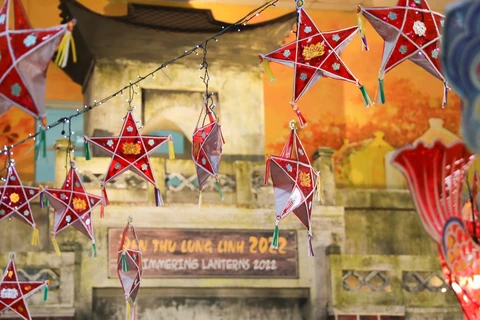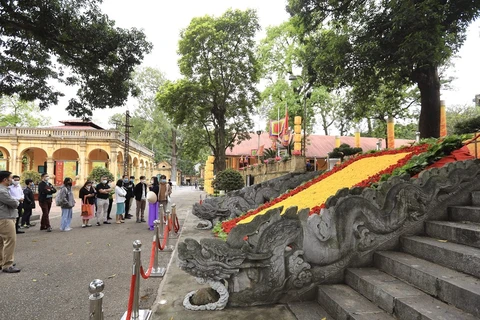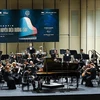 Archaelogists have found new architectural vestiges in an excavation area to the northeast of the Kinh Thien Palace relic in the Central Sector of the Imperial Citadel of Thang Long, Hanoi. (Photo: VNA)
Archaelogists have found new architectural vestiges in an excavation area to the northeast of the Kinh Thien Palace relic in the Central Sector of the Imperial Citadel of Thang Long, Hanoi. (Photo: VNA) The finding was announced at a recent scientific seminar on the outcomes of excavations conducted at the Kinh Thien Palace relic during 2022.
The newly-found vestiges are believed to date back to the Ly, Tran, Le So (Early Le), Le Trung Hung (Revival Le) and Nguyen dynasties. They provide more insights into the structure and scale of the main part of Kinh Thien Palace during the Le dynasty.
The excavation during 2022 revealed vestiges of the Dan Tri courtyard and the royal road under the Le So and Le Trung Hung dynasties.
Archaelogists also found remnants of a big wall running from East to West, with many sewers under the wall, foundations of pillars, and square floor tiles.
Besides the architectural vestiges, thousands of artefacts were also discovered, from bricks and tiles, earthenware, stoneware, metal and stone objects, which are believed to be construction materials and daily objects of the royal families.
At the seminar, scientists agreed that the findings have provided more evidence with high accuracy about the Kinh Thien Palace.
Excavation at the ancient Thang Long Citadel has been going on for 20 years, which has revealed many architectural vestiges of palaces and countless artefacts. They have allowed scientists to have a clearer vision about the architecture of Kinh Thien Palace and the palace’s space. However, the restoration of the space of Kinh Thien Palace is obstructed by the building of the Defence Ministry’s Operation Department. The Thang Long – Ha Noi Heritage Conservation Centre and scientists are coordinating to seek the most appropriate solution to the problem.
The Imperial Citadel of Thang Long is a complex of historic imperial buildings located in the centre of Hanoi, Vietnam. It was first constructed in 1011 under the reign of King Ly Thai To of the Ly dynasty. Situated in the heart of Hanoi, the Central Sector of the Imperial Citadel of Thang Long is an outstanding place of interest not only for the capital city but also for the country as a whole. The site is one of the ten special national heritage sites proclaimed by the Prime Minister in 2009 and was inscribed on the World Heritage List by UNESCO’s World Heritage Committee in 2010. Its Outstanding Universal Values are reflected in its historical longevity, its continuous role as a seat of power, and its multiple cultural layers.
According to Dai Viet Su Ky Toan Thu (Complete Annals of Dai Viet), the palace was built in 1428 under the reign of King Le Thai To (1428-33) and completed in the reign of King Le Thanh Tong (1442-97).
During the French colonial period, the colonialists demolished the Palace and built an artillery headquarters there. The building was then called the Dragon House as its front and back had the statues of stone dragons.
Presently, the remaining vestige of the ancient palace in the Imperial Citadel of Thang Long is its base.
Associate Professor Nguyen Quang Ngoc, Vice Chairman of the Vietnam Association of Historical Sciences, said at a recent workshop to review 20 years of researching, preserving and promoting the heritage value of the Imperial Citadel of Thang Long-Hanoi that with the current rate of excavation, it will take another hundred years to complete the archaeological study of the Imperial Citadel. Therefore, Ngoc suggested that it is not necessary to wait until excavation is completed to start the restoration activity. He said the work should be carried out immediately based on the newly obtained excavation results. /.
VNA






















